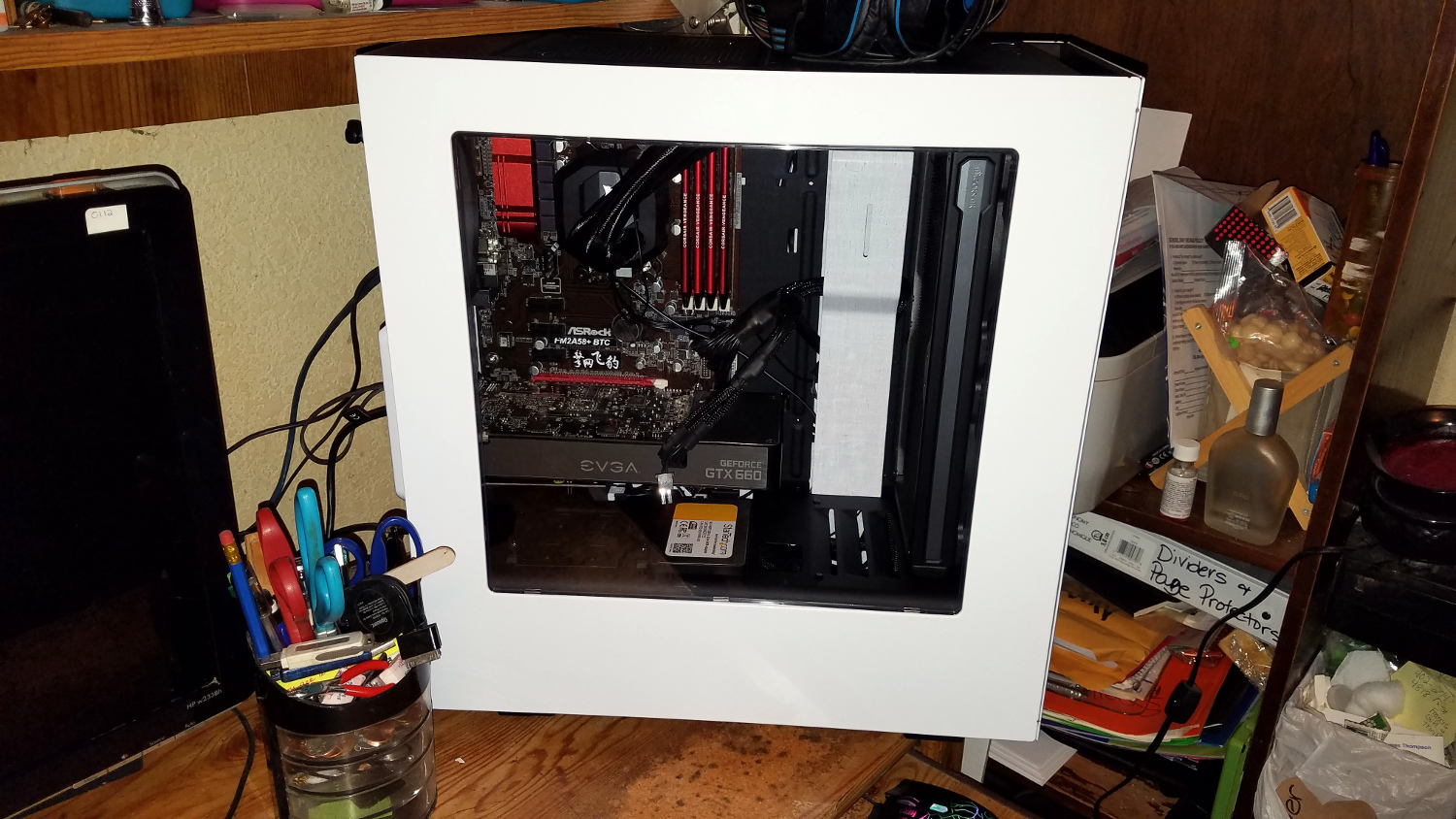Another project is now in progress, sort of. Just as Desert Sapphire was a build for one of my wife’s friends, this build will be for another of her friends. Speaking of Desert Sapphire, that one is coming due for maintenance in the coming months, so stay tuned.
This build will also be happening in two phases.
The client’s current system is a rather atrocious system that she bought from a rent-to-own place while she was still married. From what I know of the specifications, they are:
- AMD E1-1500 APU
- 16GB DDR3 RAM
- 500GB HDD
The APU is a dual-core running at 1.48GHz with a Radeon HD 7310 as the embedded GPU. It was made for laptops and netbooks, but some computer makers (e.g. HP) have also used it in cheap desktop systems. The system initially came with 4GB but was eventually upgraded to 16GB.
Time to change that. But right now I can’t afford to buy much in the way of hardware, so I’m going with something I have readily lying around. Just to give her something relatively right away that’s much better than the current setup.
Not the AMD FX-8350 that I recently pulled from β Ori when upgrading to Mira. That chip will be repurposed for something else. Instead she’ll be getting another APU, but one that’s a hell of a lot more powerful.
- AMD A8-7600
- ASRock FM2A58+ BTC
- 16GB (4x4GB) EVGA DDR3-1600
- EVGA GTX 660 SC
- Samsung 850 EVO M.2 (in a Startech M.2 to SATA enclosure)
The A8-7600 is a quad-core processor clocked at 3.1GHz, boost to 3.8GHz, so it will be able to run circles around the current system. It’s the APU I initially intended for Colony West and initially tried to use for Colony West with mixed results.
Given the system will be used primarily for World of Warcraft, or at least that’s the most stressful thing that will be run on this, I also decided to strap the stock cooler back onto one of the GTX 660s I have and put that in the system. It’ll perform significantly better than the integrated GPU, and according to Game-Debate.com, brings the system well above recommended requirements for Warcraft while also keeping power requirements lighter than if I used a GTX 680.
But I needed a few other things. The idea here is to create a setup that will be upgraded in the next phase.
- NZXT S340 White
- Corsair H115i dual-140mm All-in-One water cooler
- EVGA SuperNOVA 650 G2
The little sister to the H440 is what I selected. And to be a little different, I went with the white version. And it’s a gorgeous little case, and at 65 USD it was a bargain too given what NZXT gives you. And I loved building into it as well. Cable management capability was the best of any chassis I’ve used thus far. Only downside: no reset button. Seriously, NZXT?
Along with that, the chassis doesn’t have any active cooling across the 3.5″ HDD bays, which are out of the way under the power supply shroud with no way to even provide active cooling. Now the trend away from HDDs and toward SSDs for typical storage reflects this, with the larger H440 available for those who want to use HDDs along with or instead of SSDs, like what I have in Mira. With that, I decided against an HDD — I considered a spare 500GB drive I had laying around, but felt it’d get too hot in that location. So instead I’m throwing in a spare M.2 Samsung 850 EVO mounted inside a Startech.com M.2 to SATA enclosure.
Now the savvy reader might know that the mainboard doesn’t provide SATA III connections, only SATA II. And I was alerted to this when first attempting to run Samsung Magician. So to give it full, or nearly full, SATA III bandwidth, I have it plugged into a SIIG SC-SA0R11-S1 that I had lying around.
To kind of give an idea of the direction of the next phase, I selected the Corsair H115i to provide for overkill cooling for the APU, while remaining more than adequate for the next phase. In previous observations I found an H60, which is a single-120mm radiator, can keep the APU under 40C under full load without struggling. The H115i, which is a dual-140mm radiator, won’t have any difficulties at all.
The power supply was a toss-up. I wanted something quiet, preferably full modular. While 80+ Bronze rated PSUs would’ve saved a little money, I wanted at least Gold. And I opted for the EVGA 650 G2. For the planned parts, it’ll provide more than enough power under full load.
The power supply and AIO were ordered through Amazon (here and here) at a much, much lower price compared to Micro Center. There wasn’t much saving attempting to buy the chassis online, so it was bought locally.
So even though the first phase is not something to write home about, it’s still significantly better than the original system.

The next phase will be in December.
You must be logged in to post a comment.